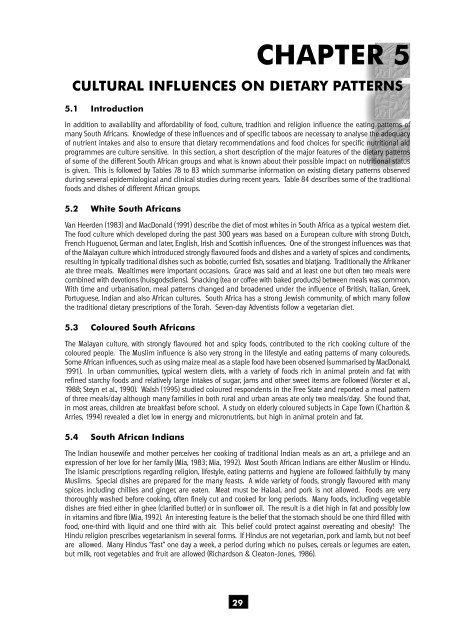the nutritional status of - Health Systems Trust
the nutritional status of - Health Systems Trust
the nutritional status of - Health Systems Trust
Create successful ePaper yourself
Turn your PDF publications into a flip-book with our unique Google optimized e-Paper software.
CHAPTER 5<br />
CULTURAL INFLUENCES ON DIETARY PATTERNS<br />
5.1 Introduction<br />
In addition to availability and affordability <strong>of</strong> food, culture, tradition and religion influence <strong>the</strong> eating patterns <strong>of</strong><br />
many South Africans. Knowledge <strong>of</strong> <strong>the</strong>se influences and <strong>of</strong> specific taboos are necessary to analyse <strong>the</strong> adequacy<br />
<strong>of</strong> nutrient intakes and also to ensure that dietary recommendations and food choices for specific <strong>nutritional</strong> aid<br />
programmes are culture sensitive. In this section, a short description <strong>of</strong> <strong>the</strong> major features <strong>of</strong> <strong>the</strong> dietary patterns<br />
<strong>of</strong> some <strong>of</strong> <strong>the</strong> different South African groups and what is known about <strong>the</strong>ir possible impact on <strong>nutritional</strong> <strong>status</strong><br />
is given. This is followed by Tables 78 to 83 which summarise information on existing dietary patterns observed<br />
during several epidemiological and clinical studies during recent years. Table 84 describes some <strong>of</strong> <strong>the</strong> traditional<br />
foods and dishes <strong>of</strong> different African groups.<br />
5.2 White South Africans<br />
Van Heerden (1983) and MacDonald (1991) describe <strong>the</strong> diet <strong>of</strong> most whites in South Africa as a typical western diet.<br />
The food culture which developed during <strong>the</strong> past 300 years was based on a European culture with strong Dutch,<br />
French Huguenot, German and later, English, Irish and Scottish influences. One <strong>of</strong> <strong>the</strong> strongest influences was that<br />
<strong>of</strong> <strong>the</strong> Malayan culture which introduced strongly flavoured foods and dishes and a variety <strong>of</strong> spices and condiments,<br />
resulting in typically traditional dishes such as bobotie, curried fish, sosaties and blatjang. Traditionally <strong>the</strong> Afrikaner<br />
ate three meals. Mealtimes were important occasions. Grace was said and at least one but <strong>of</strong>ten two meals were<br />
combined with devotions (huisgodsdiens). Snacking (tea or c<strong>of</strong>fee with baked products) between meals was common.<br />
With time and urbanisation, meal patterns changed and broadened under <strong>the</strong> influence <strong>of</strong> British, Italian, Greek,<br />
Portuguese, Indian and also African cultures. South Africa has a strong Jewish community, <strong>of</strong> which many follow<br />
<strong>the</strong> traditional dietary prescriptions <strong>of</strong> <strong>the</strong> Torah. Seven-day Adventists follow a vegetarian diet.<br />
5.3 Coloured South Africans<br />
The Malayan culture, with strongly flavoured hot and spicy foods, contributed to <strong>the</strong> rich cooking culture <strong>of</strong> <strong>the</strong><br />
coloured people. The Muslim influence is also very strong in <strong>the</strong> lifestyle and eating patterns <strong>of</strong> many coloureds.<br />
Some African influences, such as using maize meal as a staple food have been observed (summarised by MacDonald,<br />
1991). In urban communities, typical western diets, with a variety <strong>of</strong> foods rich in animal protein and fat with<br />
refined starchy foods and relatively large intakes <strong>of</strong> sugar, jams and o<strong>the</strong>r sweet items are followed (Vorster et al.,<br />
1988; Steyn et al., 1990). Walsh (1995) studied coloured respondents in <strong>the</strong> Free State and reported a meal pattern<br />
<strong>of</strong> three meals/day although many families in both rural and urban areas ate only two meals/day. She found that,<br />
in most areas, children ate breakfast before school. A study on elderly coloured subjects in Cape Town (Charlton &<br />
Arries, 1994) revealed a diet low in energy and micronutrients, but high in animal protein and fat.<br />
5.4 South African Indians<br />
The Indian housewife and mo<strong>the</strong>r perceives her cooking <strong>of</strong> traditional Indian meals as an art, a privilege and an<br />
expression <strong>of</strong> her love for her family (Mia, 1983; Mia, 1992). Most South African Indians are ei<strong>the</strong>r Muslim or Hindu.<br />
The Islamic prescriptions regarding religion, lifestyle, eating patterns and hygiene are followed faithfully by many<br />
Muslims. Special dishes are prepared for <strong>the</strong> many feasts. A wide variety <strong>of</strong> foods, strongly flavoured with many<br />
spices including chillies and ginger, are eaten. Meat must be Halaal, and pork is not allowed. Foods are very<br />
thoroughly washed before cooking, <strong>of</strong>ten finely cut and cooked for long periods. Many foods, including vegetable<br />
dishes are fried ei<strong>the</strong>r in ghee (clarified butter) or in sunflower oil. The result is a diet high in fat and possibly low<br />
in vitamins and fibre (Mia, 1992). An interesting feature is <strong>the</strong> belief that <strong>the</strong> stomach should be one third filled with<br />
food, one-third with liquid and one third with air. This belief could protect against overeating and obesity! The<br />
Hindu religion prescribes vegetarianism in several forms. If Hindus are not vegetarian, pork and lamb, but not beef<br />
are allowed. Many Hindus “fast” one day a week, a period during which no pulses, cereals or legumes are eaten,<br />
but milk, root vegetables and fruit are allowed (Richardson & Cleaton-Jones, 1986).<br />
29
















